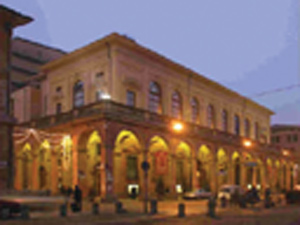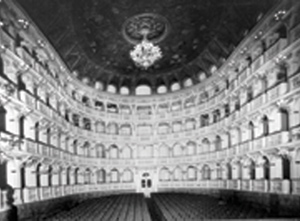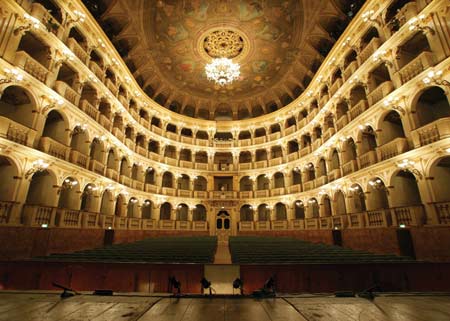The Community Theatre
by Maria Chiara Mazzi
European stage for an extraordinary musical adventure.
Today one of the regional and national points of reference for
operatic and symphonic production, Bologna's Community Theatre, when it was
founded at the end of the eighteenth century, was only the last of the many very
important and prestigious theaters in the city in that century like the Teatro
della Sala, the Teatro Formagliari and the Teatro Marsigli-Rossi. But,
from 1756, date at which the Senate of the city decided to have constructed on
the Bentivoglio site a building designed for opera, the Community Theatre,
though it was not called this way then, attracted interest: the heads wished that the theater be the
main in a city without a court (even if it was the second in importance
in the State of the Church), but among the first ones in Europe for its
availability for dialog and exchange with external counterparts, thanks to its
central position on communication routes and the presence of the
university.
But,
from 1756, date at which the Senate of the city decided to have constructed on
the Bentivoglio site a building designed for opera, the Community Theatre,
though it was not called this way then, attracted interest: the heads wished that the theater be the
main in a city without a court (even if it was the second in importance
in the State of the Church), but among the first ones in Europe for its
availability for dialog and exchange with external counterparts, thanks to its
central position on communication routes and the presence of the
university.
The
construction project was entrusted to Antonio Galli Bibiena. Immediately
followed a polemic triggered by local architects like Torreggiani and Dotti who
had little chance against one of the representatives of the most famous family
of theatre designers in the world. Bologna then immediately made clear what
would be the direction of "its theater", not forsaking its vocation for cultural
openness which would be the most important characteristic of its musical
adventure. Christoph W. Gluck, who
carried through important reforms to the art of opera, was invited to the
inauguration and proposed Triumph of Clelia for the opening which took
place May 14, 1763.
The
growth of the nineteenth century theatre was significant, facilitated by a large
number of professionals of the art of opera residing in Bologna, not only
singers, but also composers, chorus masters, impresarios, editors and
journalists, and by the relationship with the other community institutions,
above all the School of Music of which the director was also master during the
opera and symphony seasons.
It became, in short, a focal point of events which reached its
highest immediately following the
Unification of Italy from 1860 when began to be proposed in Bologna,
thanks also to an important orchestra director Angelo Mariani, lyrical and
symphonic repertoires until then rather unknown in Italy, such as Beethoven's
symphonies, the French opera of Gounod and Meyerbeer, the least known of Verdi
(Don Carlo) and, finally, Wagner.
In 1871 for the first time in Italy,
Lohengrin was played in Bologna's Community Theatre, an event of extraordinary
scope not only music-wise, but also in the aesthetic and social senses.
It
was only the first episode of a long history of special performances in Bologna,
thanks to the courage of the directors who followed Mariani, such as Mancinelli
and Martucci who contributed to the renewal of programs, to the knowledge and
dissemination of austro-german symphonic music in a country like ours
impregnated only with opera.
This is a research which culminated on the first
of January 1914 when, for the first time ever, Wagner's Persifal was played
outside of Beyruth in the Community Theatre, singing the end of World War I as
well as the height of the city of Bologna with the Martini and Rossini era.